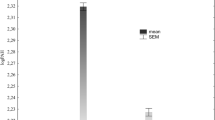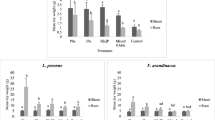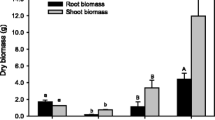Abstract
Dissipation and plant uptake of polycyclic aromatic hydrocarbons (PAHs) in contaminated agricultural soil planted with perennial ryegrass were investigated in a field experiment. After two seasons of grass cultivation the mean concentration of 12 PAHs in soil decreased by 23.4% compared with the initial soil. The 3-, 4-, 5-, and 6-ring PAHs were dissipated by 30.9%, 25.5%, 21.2%, and 16.3% from the soil, respectively. Ryegrass shoots accumulated about 280 μg·kg−1, shoot dry matter biomass reached 2.48 × 104 kg·ha−1, and plant uptake accounted for about 0.99% of the decrease in PAHs in the soil. Significantly higher soil enzyme activities and microbial community functional diversity were observed in planted soil than that in the unplanted control. The results suggest that planting ryegrass may promote the dissipation of PAHs in long-term contaminated agricultural soil, and plant-promoted microbial degradation may be a main mechanism of phytoremediation.
Similar content being viewed by others
References
Wölz J, Schulze T, Lübcke-von Varel U, Fleig M, Reifferscheid G, Brack W, Kühlers D, Braunbeck T, Hollert H. Investigation on soil contamination at recently inundated and non-inundated sites. Journal of Soils and Sediments, 2011, 11(1): 82–92
Patrolecco L, Ademollo N, Capri S, Pagnotta R, Polesello S. Occurrence of priority hazardous PAHs in water, suspended particulate matter, sediment and common eels (Anguilla anguilla) in the urban stretch of the River Tiber (Italy). Chemosphere, 2010, 81(11): 1386–1392
Flowers L, Rieth S H, Cogliano V J, Foureman G L, Hertzberg R, Hofmann E L, Murphy D L, Nesnow S, Schoeny R S. Health assessment of polycyclic aromatic hydrocarbon mixtures: Current practices and future directions. Polycyclic Aromatic Compounds, 2002, 22(3): 811–821
Wild S R, Jones K C. Polynuclear aromatic hydrocarbons in the United Kingdom environment: A preliminary source inventory and budget. Environmental Pollution, 1995, 88(1): 91–108
Wilcke W. Global patterns of polycyclic aromatic hydrocarbons (PAHs) in soil. Geoderma, 2007, 141(3–4): 157–166
Ma B, He Y, Chen H H, Xu J M, Rengel Z. Dissipation of polycyclic aromatic hydrocarbons (PAHs) in the rhizosphere: synthesis through meta-analysis. Environmental Pollution, 2010, 158(3): 855–861
Parrish Z D, Banks M K, Schwab A P. Assessment of contaminant lability during phytoremediation of polycyclic aromatic hydrocarbon impacted soil. Environmental Pollution, 2005, 137(2): 187–197
Liste H H, Alexander M. Plant-promoted pyrene degradation in soil. Chemosphere, 2000, 40(1): 7–10
Kolb M, Harms H. Metabolism of fluoranthene in different plant cell cultures and intact plants. Environmental Toxicology and Chemistry, 2000, 19(5): 1304–1310
Kucerová P, in der CWiesche M, Wolter T, Macek F, Zadrazil M, Macková M. The ability of different plant species to remove polycyclic aromatic hydrocarbons and polychlorinated biphenyls from incubation media. Biotechnology Letters, 2001, 23(16): 1355–1359
Wei S Q, Pan S W. Phytoremediation for soils contaminated by phenanthrene and pyrene with multiple plant species. Journal of Soils and Sediments, 2010, 10(5): 886–894
Lu M, Zhang Z Z, Sun S S, Wei X F, Wang Q F, Su Y M. The use of goosegrass (Eleusine indica) to remediate soil contaminated with petroleum. Water, Air, and Soil Pollution, 2010, 209(1–4): 181–189
Cofield N, Schwab A P, Banks M K. Phytoremediation of polycyclic aromatic hydrocarbons in soil: Part I. Dissipation of target contaminants. International Journal of Phytoremediation, 2007, 9(5): 355–370
Binet P, Portal J M, Leyval C. Dissipation of 3-6-ring polycyclic aromatic hydrocarbons in the rhizosphere of ryegrass. Soil Biology and Biochemistry, 2000, 32(14): 2011–2017
Joner E J, Leyval C. Influence of arbuscular mycorrhiza on clover and ryegrass grown together in a soil spiked with polycyclic aromatic hydrocarbons. Mycorrhiza, 2001, 10(4): 155–159
Kirk J L, Klironomos J N, Lee H, Trevors J T. The effects of perennial ryegrass and alfalfa on microbial abundance and diversity in petroleum contaminated soil. Environmental Pollution, 2005, 133 (3): 455–465
Rezek J, in der Wiesche C, Macková M, Zadrazil F, Macek T. The effect of ryegrass (Lolium perenne) on decrease of PAH content in long term contaminated soil. Chemosphere, 2008, 70(9): 1603–1608
Canadian Council of Ministers of the Environment. Canadian Soil Quality Guidelines for the Protection of Environmental and Human Health: Summary Tables. Updated 7.0. Winnipeg, CCME, 2007
Qian W, Ni J Z, Luo Y M, Li X H, Zou D X. Determination of polycyclic aromatic hydrocarbons in soil by high performance liquid chromatography with fluorescence detection. Chinese journal of Chromatography, 2007, 25(2): 221–225 (in Chinese)
Singh J, Singh D K. Dehydrogenase and phosphomonoesterase activities in groundnut (Arachis hypogaea L.) field after diazinon, imidacloprid and lindane treatments. Chemosphere, 2005, 60: 32–42
Teng Y, Luo Y M, Gao J, Li Z G. Combined remediation effects of arbuscular mycorrhizal fungi-legumes-rhizobium symbiosis on PCBs contaminated soils. Environmental Science, 2008, 29:2925–2930 (in Chinese)
Zak J C, Willig M R, Moorhead D L, Wildman H G. Functional diversity of microbial communities: A quantitative approach. Soil Biology and Biochemistry, 1994, 26:1101–1108
Vervaeke P, Luyssaert S, Mertens J, Meers E, Tack F M G, Lust N. Phytoremediation prospects of willow stands on contaminated sediment: A field trial. Environmental Pollution, 2003, 126(2): 275–282
Xu S Y, Chen Y X, Wu W X, Wang K X, Lin Q, Liang X Q. Enhanced dissipation of phenanthrene and pyrene in spiked soils by combined plants cultivation. Science of the Total Environment, 2006, 363(1–3): 206–215
Cheema S A, Imran Khan M, Shen C F, Tang X J, Farooq M, Chen L, Zhang C K, Chen Y X. Degradation of phenanthrene and pyrene in spiked soils by single and combined plants cultivation. Journal of Hazardous Materials, 2010, 177(1–3): 384–389
Choi W J, Chang S X. Technical note: nitrogen fertilization effects on the degradation of aged diesel oil in composted drilling wastes. International Journal of Phytoremediation, 2009, 11(5): 441–450
Smith K E, Schwab A P, Banks M K. Dissipation of PAHs in saturated, dredged sediments: A field trial. Chemosphere, 2008, 72 (10): 1614–1619
Zhang J, Yin R, Lin X G, Liu W W, Chen R R, Li X Z. Interactive effect of biosurfactant and microorganism to enhance phytoremediation for removal of aged polycyclic aromatic hydrocarbons from contaminated soils. Journal of Health Science, 2010, 56(3): 257–266
Sun T R, Cang L, Wang Q Y, Zhou DM, Cheng JM, Xu H. Roles of abiotic losses, microbes, plant roots, and root exudates on phytoremediation of PAHs in a barren soil. Journal of Hazardous Materials, 2010, 176(1–3): 919–925
Xu S Y, Chen Y X, Lin K F, Chen X C, Lin Q, Li F, Wang Z W. Removal of pyrene from contaminated soils by white clover. Pedosphere, 2009, 19(2): 265–272
Cheng K Y, Lai K M, Wong J W C. Effects of pig manure compost and nonionic-surfactant Tween 80 on phenanthrene and pyrene removal from soil vegetated with Agropyron elongatum. Chemosphere, 2008, 73(5): 791–797
Johnson D L, Anderson D R, McGrath S P. Soil microbial response during the phytoremediation of PAH contaminated soil. Soil Biology and Biochemistry, 2005, 37(12): 2334–2336
Author information
Authors and Affiliations
Corresponding author
Rights and permissions
About this article
Cite this article
Fu, D., Teng, Y., Shen, Y. et al. Dissipation of polycyclic aromatic hydrocarbons and microbial activity in a field soil planted with perennial ryegrass. Front. Environ. Sci. Eng. 6, 330–335 (2012). https://doi.org/10.1007/s11783-011-0366-7
Received:
Accepted:
Published:
Issue Date:
DOI: https://doi.org/10.1007/s11783-011-0366-7




